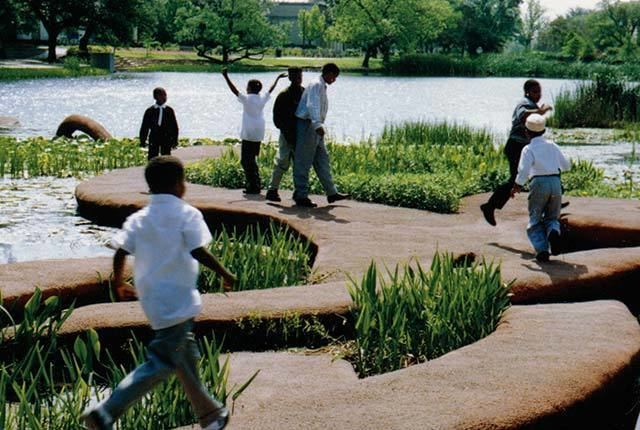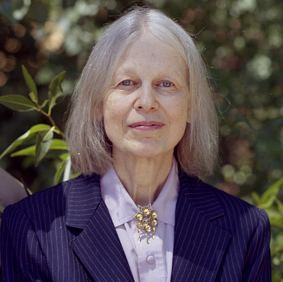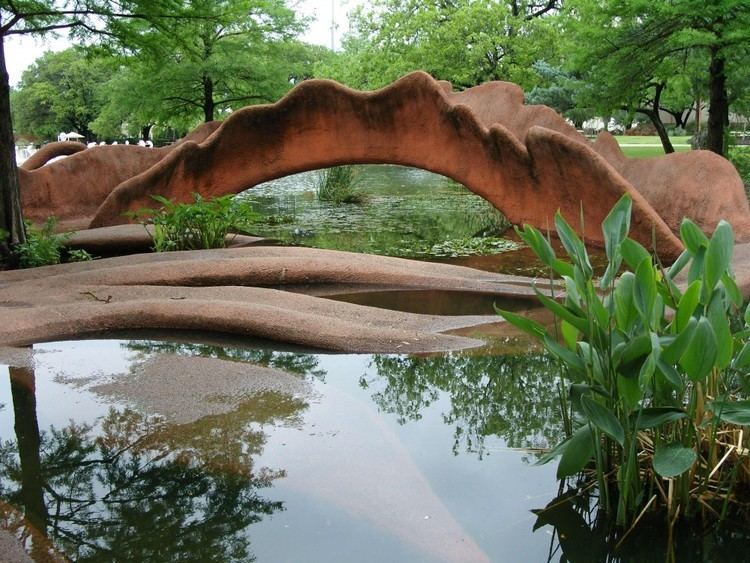Name Patricia Johanson | Role Artist | |
 | ||
Full Name Patricia Johanson Books Art and Survival: Creative Solutions to Environmental Problems Awards Guggenheim Fellowship for Creative Arts, US & Canada | ||
Ecoartspace video archive patricia johanson interview
Patricia Johanson (Born September 8, 1940, New York City) is an American artist.
Contents
- Ecoartspace video archive patricia johanson interview
- Art that heals the earth with patricia johanson
- Early life education
- Minimalist Art Works
- The House and Garden Commission 1969
- Plant Drawings for Projects 1974 78
- Water and Color Garden Designs 1980 85
- Leonhardt Lagoon Dallas 1981 1986
- Endangered Garden San Francisco 1987 97
- Park for the Amazon Rainforest Obidos Brazil 1992
- The Rocky Marciano Trail Brockton Massachusetts 1997 1999
- Millenium Park Landfill Site Seoul Korea 1999
- Petaluma Wetlands Park and Ellis Creek Water Recycling Facility Petaluma California 2001 09
- The Draw at Sugar House Salt Lake City Utah 2003 present
- Marys Garden Marywood University Scranton Pennsylvania 2008 present
- What Others Have Said About Patricia Johanson
- Public Collections with Works by Patricia Johanson
- Awards
- Side Note
- References

Patricia Johanson is known for her large-scale art projects that create aesthetic and practical habitats for humans and wildlife. She designs her functional art projects, created with and in the natural landscape, to solve infrastructure and environmental problems, but also to reconnect city-dwellers with nature and with the history of a place. These project designs date from 1969, making her a pioneer in the field of ecological-art (or eco-art.) Johanson’s work has also been classified as Land Art, Environmental Art, Site-specific Art and Garden Art. Her early paintings and sculptures are part of Minimalism.

Art that heals the earth with patricia johanson
Early life & education

Johanson’s enthusiasm for nature and for art began in childhood. She grew up in New York City, where she spent countless hours in Frederick Law Olmsted parks. Her mother, a former model, introduced her to the arts. As a high school student, she excelled at music, but at Bennington College (1958–1962) she was a painting major.

Through her contacts at Bennington, Johanson became part of the 1960s New-York art-world. Her Bennington instructor, Tony Smith (sculptor), was a close friend and her art-history professor, Eugene Goossen, a mentor and later her husband. At this time she met fellow-artists Kenneth Noland, David Smith (sculptor), Helen Frankenthaler, Franz Kline, Philip Guston and Joseph Cornell. She also came to know art-critic Clement Greenberg and visionary architect Frederick John Kiesler.

Johanson earned a Master’s in art history at Hunter College, New York in 1964. There she studied with Tony Smith, Eugene Goossen and Ad Reinhardt and met fellow art students Robert Morris, Carl Andre and Robert Barry. At this time, she worked as a researcher for New York publisher Benjamin Blom on a compendium of 18th and 19th century American artists. The project led to an opportunity to catalogue the work of Georgia O'Keeffe, who became an important mentor.

Her husband, art critic and historian Eugene Goossen, died in 1997.
Minimalist Art Works
Johanson’s paintings and sculptures of the 1960s have been classified as Minimalism and they were included in some of the earliest shows of Minimal Art: “8 Young Artists” (1964), “Distillation” (1966) and “Cool Art” (1968). Her Minimalist paintings used simple lines to explore the optical effects of color. These were shown at the Tibor de Nagy Gallery in New York in the 1960s and her 28-foot-long (8.5 m) oil painting, William Clark, was included in the 1968 Museum of Modern Art contemporary art survey, “The Art of the Real”
Johanson began making large-scale, Minimal sculpture in 1966 with William Rush, consisting of 200 feet (61 m) of painted steel tee-beams laid flat in a clearing. In 1968 she increased her scale to 1,600 feet (490 m) with Stephen Long (inspired by the 19th century topographical and railway engineer), where 2-foot-wide (0.61 m), painted plywood segments were installed along an abandoned railroad track in Buskirk, New York. This was followed by other large-scale Minimalist sculptures sited outdoors. Johanson’s Minimalst sculptures introduced the idea of artworks that cannot be experienced all at once, still an important value in her work.
Cyrus Field (1970–71), while still a large Minimalist sculpture, marks a transition. Using marble, cement and redwood slabs in their natural state, she created a maze of lines that lead visitors through a forest to reveal the changing, natural landscape. With this piece she began thinking of line as a compositional device to incorporate, rather than displace, nature. She also invented a way to mediate between human scale and the vastness of nature.
The House and Garden Commission (1969)
In 1969, House & Garden (magazine) invited Johanson to design a garden. While this was never built, the commission prompted an outpouring of visionary ideas—150 small sketches—which she has continued to draw upon over the years. The drawings, accompanied by essays and explanatory notes, were a departure from traditional garden designs and also a rejection of the formalist orientation of the 1960s art world. Instead of art-for-art’s sake, her garden designs embodied meaningfulness and functionality.
Johanson’s move from making objects to working with the natural world—at first in drawings and later in actual commissions—has parallels (as well as differences) with the emergence of Earthworks by artists in her circle of friends, such as Robert Smithson and Nancy Holt. The similarity is working large-scale with the land itself. A difference is that many of Johanson’s designs were meant to serve practical functions, such as flood control, habitat for local wildlife, and green roofs that absorb rainwater. Johanson also designed for urban, rather than remote locations. Another difference is that most of her designs are dominated by a simple, large image of a plant or animal.
The House and Garden designs mark a reorientation in Johanson’s career. She gave up painting and sculpture and now focused on designs that are simultaneously art and landscape To prepare herself for translating project designs into large-scale sculptural landscapes, she began studying civil engineering and architecture at City College School of Architecture, New York, in 1971, receiving her B. Arch. in 1977.
Plant Drawings for Projects: 1974-78
In the 1970s, Johanson began a family and settled in upstate New York, where she has lived ever since. She left the vibrant New York art scene for a 19th-century farmhouse on the rural Buskirk property of Eugene Goossen. Her first son, Alvar, was born in 1973 (followed by Gerrit in 1978 and Nathaniel in 1980). Here she was in constant touch with the natural seasons, but childrearing left only snatches of time to work.
Her solution was to make tiny drawings of plants during the day and at night to transform them into designs for large-scale projects. At this time, she also studied botany texts. This was a new process: instead of depending on inspiration, she rendered nature in a straightforward way.
Water and Color Garden Designs: 1980-85
In the 1980s, even as Johanson began her first built projects, she created several series of project drawings for gardens and fountains that emphasize water and color in the form of gigantic flowers, butterfly wings or snakes. For example, Tidal Color Gardens (1981–82) increase the visibility of tides, with images of butterfly wings or flowers changing as water flows in and out. The O’Keeffe/Equivalents-Color Garden are drawings for earth sculptures in the form of a butterfly wing with color patterns based on Alfred Stieglitz photographs of O’Keeffe.
Leonhardt Lagoon, Dallas (1981-1986)
Johanson’s first built project was commissioned in 1981 to restore Fair Park's Leonhardt Lagoon, which was then in a badly degraded state. To solve the problems of an eroded shoreline, murky water and algal bloom, Johanson devised large sculptural forms that broke up wave action and selected indigenous plantings as microhabitats for wildlife. The gigantic, terra cotta-colored gunite sculptures, which doubled as pathways for human visitors and perches for birds and turtles, take the form of a Delta Duck-potato (Sagittaria platyphylla) and a Spider Brake Fern (Pteris multifida). Today Leonhardt Lagoon is a functioning ecosystem in the heart of Dallas, where it also serves as a place of education and recreation. This is one of the earliest examples of art as bioremediation. For this and other large-scale urban projects, she works with a variety of experts, including scientists, engineers, and city planners, as well as local citizen groups.
Endangered Garden, San Francisco (1987-97)
When San Francisco needed a new pump station and holding tank next to the Bay, Johanson was invited to co-design a facility that would be sensitive to the site. She wanted something aesthetic, but also useful in ways beyond mere sewage treatment, so she designed a series of habitats to nourish threatened species. The roof of the sewer is a one-third-mile-long baywalk whose colors and patterns derive from the endangered San Francisco garter snake. The head of the serpent is a 20-foot-high (6.1 m) mound that serves as a microhabitat for butterflies. The Ribbon Worm Tidal Steps fills with water at high tide, creating homes for small marine life.
Park for the Amazon Rainforest, Obidos, Brazil (1992)
In 1992, the Brazilian government invited Johanson to attend the Earth Summit and to create a project for a park in the Amazon Rainforest. Her model for this shows a 150-foot-high (46 m) ramp, in the form of a Brazilian aerial plant, that allows visitors to experience a range of microhabitats at various levels. The ramp itself is intended to become encrusted by tropical vegetation. This project has been disrupted several times by changes in government and is currently on hold.
The Rocky Marciano Trail, Brockton, Massachusetts (1997-1999)
This project, which art critic Lucy Lippard calls a favorite, began as an effort to stimulate Brockton’s economy. Johanson developed a master plan to connect disparate neighborhoods and districts and to restore ecological functioning. Since Rocky Marciano is a Brockton celebrity, she planned to use his training routes as a way to connect neighborhoods and nature. The Rocky Marciano Trail begins at the Marciano home and leads visitors to various “magnet sites,’‘ such as Thomas McNulty Park and Battery Wagner, both enhanced by Johanson’s cultural and environmental designs. She also planned to daylight the many buried or disrupted streams throughout the town and to revive forest corridors to create a continuous public landscape. This project was rejected by the city of Brockton.
Millenium Park Landfill Site, Seoul, Korea (1999)
In 1999, Johanson was part of an international team of experts asked to propose sustainable solutions for Seoul’s main dumpsite, which closed in 1990. To reclaim the site her idea was to transform it into a park and to restore ecological communities. As a unifying image, she chose the haetae, a mythical animal that wards off evil. She borrowed decorative patterns of haetae sculptures to create designs for terraces, microhabitats, and pedestrian and vehicle access to the summits.
Petaluma Wetlands Park and Ellis Creek Water Recycling Facility, Petaluma, California (2001-09)
Working as a member of the Carollo Engineers design team, Johanson helped create a new water treatment facility. By overlaying art, public access, sewage treatment, habitat restorations, and agriculture, she embedded major urban infrastructure within living nature. Her design has been credited with "re-inventing art and reforming civil engineering". The project includes natural systems to treat sewage, allowing millions of gallons of water to be reused. Johanson used the form of the endangered Salt Marsh Harvest Mouse to create the shapes of the polishing ponds, which contain islands that direct the flow of water and provide nesting habitat for birds. Other plantings support local wildlife. An additional 230-acre (0.93 km2) area of tidal wetlands was acquired for the park and wildlife sanctuary. This multi-purpose landscape provides more than 3 miles (4.8 km) of walking trails for educational programs, nature study and tourism. Petaluma Wetlands Park coincides with a $150 million sewage treatment facility, while also serving as a highly visible model for converting sewage into recycled water, which is stored in a deep reservoir at the end of the "mouse's tail".
The Draw at Sugar House, Salt Lake City, Utah (2003-present)
The Salt Lake nonprofit, Parley’s Rails, Trails and Tunnels Coalition commissioned Johanson to create safe passage under a major expressway and connect two sections of the planned eight-mile (13 km) Parley’s Trail. The design encompasses two gigantic sculptures based on the native Sego Lily (Calochortus nuttallii) and an historic canyon, which are respectively located east and west of the expressway and connected by an underpass. As practical infrastructure, the Sego Lily serves as a diversion dam, while the canyon functions as flood wall, spillway, and provides wildlife habitat. Simultaneously, the sculptures serve as climbing walls, overlooks, a trail and plaza. The underpass will mimic a Utah canyon, with embedded coal seams and fossil formations. The design is multilayered to offer visitors opportunities to connect in a variety of ways with references to local ecology, geology, and specific sculptural formations to recall the Mormon journey through Echo Canyon.
Mary’s Garden, Marywood University, Scranton, Pennsylvania (2008-present)
Mary’s Garden is designed to remediate a coal mining site, which was purchased by the Sisters, Servants of the Immaculate Heart of Mary in 1969. The garden incorporates elements that purify water and provide wildlife habitat while also referencing the cultural, geological and natural history of the place. Two large sculptural formations, Madonna Lily and Mary’s Rose, based on traditional religious symbols, shape the two main areas of the five-acre site. Remnants of mining activity and forms made of local stratified rock reference the previous, industrial uses of the land and geological eras. Seating and pathways offer opportunities for relaxation and contemplation of plants and wildlife at close range.
What Others Have Said About Patricia Johanson
“Of all the artists (so many of them women) who have become known over the last few decades for large-scale public art in/with nature—what is now called ‘eco-art,’ Johanson stands out as a seldom-acknowledged pioneer. Her writings of the late 1960s, when she was still in her twenties, are a cornucopia of possibilities for environmental art and planning that are still being ‘discovered’ today.”
“Johanson’s working model is the ecosystem and survival is her core theme, one she knows all too well, personally and politically”.
“Patricia Johanson was one of the first artists to think of art as a means to restore habitats and her work is an outstanding model for maintaining biodiversity. By creating art that revitalizes natural ecosystems and introduces them to urban dwellers, she has become an innovator in art, ecology, and urban renewal.”
“Johanson teaches that artists can be vital, visionary forces in creating social and environmental change.”
Public Collections with Works by Patricia Johanson
Allen Memorial Art Museum, Oberlin College, Oberlin, Ohio
Dallas Museum of Art, Dallas
Metropolitan Museum of Art, New York
Museum of Modern Art, New York
National Museum of Women in the Arts, Washington, D. C.
Storm King Art Center, Mountainville, New York
Awards
Guggenheim Fellowship, 1970
Artist’s Fellowship, National Endowment for the Arts, 1975
International Women’s Year Award, 1976
Townsend Harris Medal, City College of New York, 1994
D.F.A. (honorary), Massachusetts College of Art, Boston, 1995
Side Note
This information was researched and written by Patricia Sanders Phd. I have simply been her computer helper.
